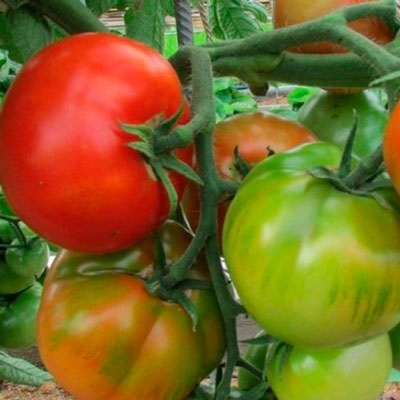
- Category: grade
- Growth type: determinant
- Appointment: universal
- Ripening period: early
- Growing conditions: for open ground, for greenhouses
- Transportability: Yes
- Leaves: dark green
- Ripe fruit color: Red
- Fruit shape: ribbed, flat-round
- Fruit weight, g: 200-300
First of all, on his site, the gardener tries to grow tomatoes that are not capricious in care, adapt to growing conditions, and also give good yields. These include the early Staroselsky variety, which is grown both in the garden and under the film.
Breeding history
This early ripe tomato is the brainchild of a group of domestic amateur breeders. The nightshade crop is not included in the State Register of Breeding Achievements, but it is in high demand among vegetable growers. The plant is recommended for growing in regions with warm and temperate climates. The productivity of the variety is good both in protected ground conditions and in the garden.
Description of the variety
The Staroselsky tomato is a medium-sized plant of the determinant type. The bush grows up to 100 cm in height. It is characterized by a strong central stem, medium thickening with dark green leaves, moderate branching, a developed root and simple inflorescences. Each fruit cluster produces from 7 to 9 berries.
When growing a plant for high yields, it is recommended to form 3-4 stems, periodically remove the side stepsons, and also tie up the branches and the central trunk. The purpose of the vegetable is universal. It is widely used in cooking, eaten fresh, canned, pickled, processed into drinks, dressings, sauces.
The main qualities of the fruit
Staroselsky tomato belongs to the group of large-fruited nightshade. The vegetable has a flat-round shape with a slight ribbing of the surface at the stalk. The average weight of a vegetable can vary from 200 to 300 grams. Ripe tomato is evenly covered with a rich red color. At the stage of ripening, the fruit changes color several times - from milky to light green with a dark spot at the base. The skin of the vegetable is quite dense, slightly harsh. The advantage of the vegetable is its resistance to cracking, transportability and long shelf life while preserving all the useful properties of tomatoes. The fruits, taken in a state of technical maturity, ripen perfectly at room temperature.
Taste characteristics
The variety has an excellent ripe berry taste. The flesh of vegetables is fleshy, dense, very juicy, with a low content of seeds and with sugar content at the break. Tomatoes have a balanced, delicate, sweet taste with a slight sourness and spicy aroma.
Ripening and fruiting
Tomato represents a class of early maturing nightshade crops. From the mass germination of seedlings to ripe fruits on the bushes, 3 months pass - 85-95 days. The ripening of the culture is friendly, so you can remove the berries with whole fruit clusters. The period of mass release of fruits falls on the end of June - July. Ripe tomatoes should be removed immediately without overexposing, as this may affect the taste.
Yield
Staroselsky solanaceous culture is high-yielding. Subject to standard agricultural practices, 6.5 kg of tomatoes can be harvested per 1 m2 per season.
The timing of planting seedlings and planting in the ground
The plant is grown exclusively by the seedling method. Sowing seeds is performed in the second half of March (40-50 days before the transfer of bushes).The seed is carefully sorted and disinfected. For fast germination and healthy growth, it is necessary to provide the right conditions - a temperature of 20-25 degrees and lighting for more than 14-16 hours a day.
After 2-3 leaves appear on the bush, they can be seated in separate cups. 10-15 days before transplanting, it is recommended to start hardening the bushes little by little, so that adaptation to new growing conditions is painless.
Tomatoes can be planted in the garden from mid-May, when the air and soil are warmed up. In the greenhouse, the transplant is carried out in early May.

Growing tomato seedlings is an extremely important process, because it largely depends on whether the gardener will be able to harvest at all. All aspects must be taken into account, from seedbed preparation to planting in the ground.
Landing scheme
Their development and productivity depend on the correct placement of plants in the garden. It is recommended to grow 3 bushes per 1 m2. The optimal layout for planting is 30x40 cm.

Growing and care
The species is unpretentious in care, but picky about the nutritional value of the soil. The site is cleared of weeds and other debris in advance, dug up, which will ensure sufficient air permeability, and organic fertilizers are applied.
In addition, the site should be well lit by the sun. To get an excellent harvest, you need to take care of the crop: water with settled water, apply top dressing, weed and loosen the soil, form and tie up bushes, partially pinch, thin out the foliage in the lower part of the plants, and also take preventive measures to protect against fungi and insects.




A plant needs different micronutrients at each stage of growth. All fertilizers can be divided into two groups: mineral and organic. Folk remedies are often used: iodine, yeast, bird droppings, eggshells.
It is important to observe the rate and period of feeding. This also applies to folk remedies and organic fertilizers.
Disease and pest resistance
The plant has a high immune defense. Tomato is not susceptible to tobacco mosaic virus and late blight. Preventive treatments with insecticides will help protect against the invasion of pests.


Resistant to adverse weather conditions
The culture has good resistance to stress. She is absolutely tolerant of minor cold snaps, short drought and heat.

























































































